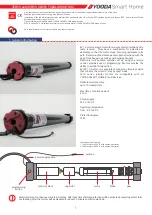
and D2 on the E1507 PC board, are probably the cause of the problem.
Since these components are not recommended as field replaceable, the
E1507 PC board should be replaced or the entire control should be
returned to Polyspede factory for repair. If the bulb does not light, turn
power off and reconnect the connections to10TB if they are presently not
connected. (A1, A2, and motor field leads are still disconnected at the
motor.) Reapply power. If, with the speed pot at zero, the bulb burns, go
back to step (e). If the bulb does not burn, go to step (g).
g)
If no faults are located in the preceding steps, or if they have already been
corrected, leave light bulb connected as in the preceding steps and
reconnect A1 and A2 wires at the motor. Leave field wires disconnected
and insulated. All wires at this point should be connected except the field
wires. Set the speed control pot at zero and turn on all power. Light should
not burn. Increase the speed setting to 20%. Lamp brilliance should
increase smoothly to nearly full brilliance. [NOTE: Lamp flicker and
erratic brilliance may be observed at settings about 15-20%; this is
normal.] The FB SELECT plus 2PL should have pins 1 and 2 jumpered
together during this step.
h)
Repeat step (g) with motor field wires connected. Results should be
similar except that the bulb will burn at about one-half brilliance with
speed control set to zero due to motor field current, and will increase to
nearly full brilliance at 15% or 20% setting of the speed pot.
i)
If operation is normal in all preceding steps, remove the light bulb and
reconnect all wiring for normal operation.
j)
If occasional fuse blowing occurs, an intermittent short or ground is
indicated. Inspect motor leads and motor brush pigtails for possible faults.
Inspect the OC2 control unit for loose foreign objects (washers, nuts, wire
clippings, etc.). Test all internal wiring. If the problem seems to be in the
DC motor, refer to the Motor Tests, Section 10.
14
















































